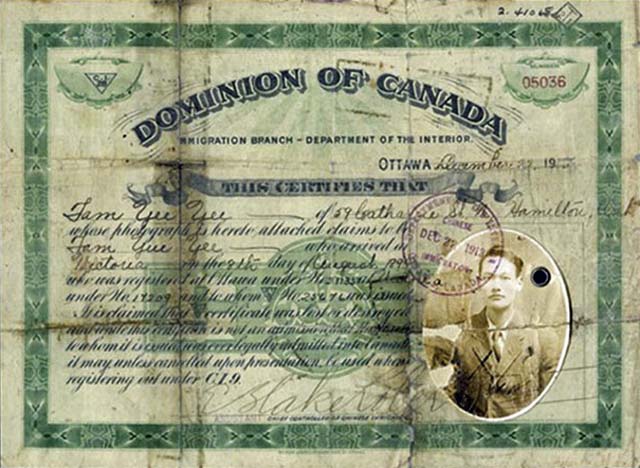
Ottawa Ontario - The Canadian Pacific Railway (CP) is touted as one, if not, the preeminent engineering project for the then young and developing
nation of Canada.
The political and economic benefit of linking the nation together by rail came at a heavy and sometimes fatal price for the Chinese labourers who brought the
railway into being in British Columbia.
One of the conditions of B.C.'s entry into the Dominion of Canada on 20 Jul 1871 was a guarantee that the CP would be built across it to link British Columbia
to the rest of Canada.
Though B.C. entered Confederation in 1871, the route for the railroad was not determined until 1879.
At the same time, gold rushes both in Canada and the United States brought immigrants from across the globe to the west coast, particularly Chinese migrants,
who also left China to escape internal strife, famine, and natural disasters.
But while manpower meant the railway would be built across B.C., it came with a racist backlash that in some ways persists to this day.
According to the book "Blood and Sweat over the Railway Tracks" by Lily Chow, even at the point of calls for tenders being issued, editorials
appeared in the Victoria Daily Colonist warning Asians would take work away from white labourers, and organizations such as the Anti-Chinese Association of
Victoria met to pass resolutions insisting no Chinese be allowed to work on the railway.
Charles Tupper, then the Minister of Railways, refused to allow restrictions of labour for the project because he wanted it completed quickly and
economically.
In 1882, Prime Minister John A. Macdonald stated in Parliament, "It is simply a question of alternatives. Either you must have this (Chinese) labour or
you can't have the railway."
Though the federal government required the hiring of Chinese workers, work conditions for these labourers were significantly poorer than for workers with a
European background.
"The Chinese-Canadian community building the railroad certainly were given the worst and most dangerous jobs, the least amount of pay, and many lives were
lost in that process," Vancouver East MP Jenny Kwan said.
Chinese-Canadians were also discriminated against in other ways, Kwan said, including leprosy sufferers being put on Darcy Island against their
will.
"There was wood delivered there once a month so the sick could bury the dead. That's part of our Canadian history, and it's pretty appalling if you ask
me," Kwan said.
Chinese Canadians were also not allowed to own property or enter certain professions, she added, and were segregated from other communities.
"Chinatown was born largely because a lot of clan associations started to fundraise and build a place where Chinese Canadians could live together,
socialize, and in some cases work together in the same hub," Kwan said.
The railway work was dangerous and physically demanding, requiring drilling through mountains of solid granite in order to build tunnels.
Chinese workers were also not allowed to handle dynamite and other explosives, but nonetheless fell victim to dynamite explosions, rock falls, and landslides
that took place without sufficient warning.
Poor nutrition, crowded living conditions, and cold winter weather also contributed to sickness and disease, including respiratory ailments and
scurvy.
Chinese and First Nations workers did some of the most dangerous work, in the process forming a bond between the two peoples.
"At the time when the Chinese people were severely mistreated and discriminated against, it was actually the First Peoples who came to their aid,
supported them, offered them food, shelter, and friendship, and I think that relationship is part of history that people don't know about," Kwan
said.
"This was at a time that indigenous people were also being discriminated against and mistreated, but they found it within their heart to offer and extend
a hand to help those who were also being mistreated," she added.
Chinese workers were also often required to pack up their shelters and belongings and mobilize to another work site in a short period of time.
In her book, Chow notes that while a large number of Chinese workers could move many miles over 24 hours, the same task with an equal number of white workers
would take a week.
Recognition of the mistreatment of Chinese immigrants was a drawn-out process, fighting both historical inertia and racist laws which charged a "head
tax" on Chinese immigrants from 1885 to 1923 and then restricted immigration from China altogether until 1947.
In 1989, a monument to Chinese railway workers was erected in Toronto, but to date a similar monument does not exist in B.C., though there is a commemorative
plaque on the Chinese Cultural Centre in Vancouver.
In 2005, the CP named an interchange near Kamloops, B.C. as the Cheng Interchange in honour of Cheng Going Butt, one of the labourers who helped build the
railroad.
Margaret Mitchell, the former MP for Vancouver East was the first to ask at the federal level for a redress of the Chinese head tax in 1984, Kwan
said.
The then Prime Minister Stephen Harper administration issued an apology and redress in 2006 for the descendants of those discriminated against.
Kwan participated in writing a motion for a formal apology which the B.C. provincial government supported and was unanimously accepted by the
legislature.
"I think in that process we both exposed both a lot of the discriminatory practices in our history, and also a recognition of war veterans, railway
workers, all the people who really helped build Canada," Kwan said.
Warren Frey.
OKthePK Joint Bar Editor: The Chinese head tax cost $50 between 1885 and 1903 then it was increased to $500 until 1923.
of the Canadian Copyright Modernization Act.


